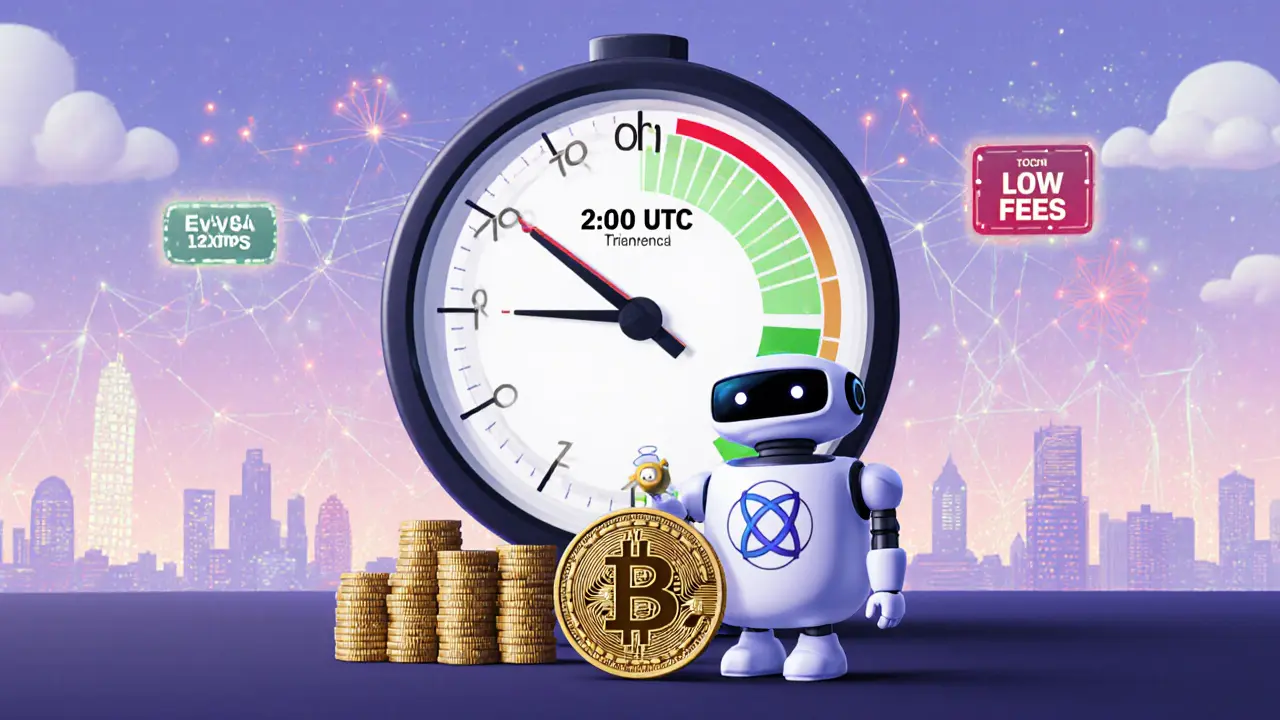Crypto Transaction Fee Calculator
Calculate estimated transaction fees for popular cryptocurrencies before sending. This tool uses real-time data to show costs based on network congestion, transaction complexity, and current fee rates.
Select Network
Ever sent a Bitcoin and got shocked by a $15 fee on a $50 transfer? You’re not alone. In 2025, crypto transaction fees aren’t just a nuisance-they’re a core part of how blockchains work, and understanding them can save you hundreds a year. Whether you’re sending stablecoins for your online store, trading ETH, or just moving crypto between wallets, fees can make or break your experience. The good news? You don’t need to be a developer to control them. The bad news? Most people still don’t know what’s really driving those costs.
Why Crypto Fees Are So Different Across Networks
Not all blockchains charge fees the same way. Bitcoin uses a byte-based system, where your fee depends on how much data your transaction takes up. A simple send with one input and one output? Small. A transaction that combines 20 old payments? Big. That’s because each input adds more data, and miners charge per virtual byte (vByte). In 2025, Bitcoin fees can swing from under $0.50 during quiet hours to over $10 during market spikes. Ethereum, on the other hand, uses gas. Here, the cost isn’t about size-it’s about complexity. Sending ETH? Cheap. Swapping tokens on Uniswap? Expensive. Executing a DeFi strategy with multiple smart contracts? That could cost $20 or more. Gas prices rise when the network is busy, like during an NFT drop or a surge in yield farming. In Q1 2025, Ethereum gas fees hit $18 average during peak DeFi activity, according to BitGo’s February report. Then there are the low-fee outliers. Tron, built on Delegated Proof of Stake, charges under $0.01 per transaction-and many are free. IOTA doesn’t charge anything at all. Why? Because it doesn’t use miners or validators. Instead, every user who sends a transaction must approve two others. No middlemen, no fees. TRM Labs confirmed in August 2025 that IOTA’s transaction costs are effectively zero, making it ideal for IoT devices sending micro-payments every few seconds.Network Congestion Is the #1 Fee Driver
The biggest reason your fee spikes isn’t because the network got “more expensive.” It’s because it got crowded. Think of it like highway traffic. When everyone rushes to get on the road at the same time, you pay more to get ahead. Bitcoin’s mempool-the queue of unconfirmed transactions-fills up during market rallies, holidays, or big news events. In March 2025, during a Bitcoin price surge, the mempool peaked at over 400,000 transactions waiting to be confirmed. Users who wanted their transaction processed fast had to bid up the fee rate, sometimes paying 5x the normal rate. Reddit user u/BlockchainTrader89 reported paying $15 in fees to send $50-something that would’ve cost $0.80 on a normal Tuesday. Ethereum’s congestion works similarly. When a new NFT collection drops, gas fees spike because hundreds of thousands of users are trying to mint at once. In April 2025, the average gas fee hit 85 Gwei during a major NFT launch, up from 15 Gwei the week before. That’s a 466% increase. The lesson? Timing matters. Bitcoin fees are typically lowest on Tuesday and Wednesday mornings (UTC). Avoid weekends and major market events if you’re sending small amounts. Many experienced users check mempool.space or BitcoinFee.info before hitting send.Transaction Size Matters More Than You Think
On Bitcoin, your fee isn’t tied to how much you send-it’s tied to how complex the transaction is. If you’ve been holding Bitcoin since 2017 and have hundreds of small UTXOs (unspent outputs), every time you spend, you’re combining dozens of inputs. That makes your transaction huge. A single-input, single-output transaction is about 140 vBytes. A 10-input transaction? Around 700 vBytes. At a fee rate of 50 satoshis per byte, that’s $0.35 vs. $1.75. That’s a 500% difference for sending the same amount of BTC. The fix? Consolidate your UTXOs during low-fee periods. If you’ve got 50 small inputs, spend them all in one go when fees are under $0.50. That way, you’re paying one low fee instead of 50 high ones later. This doesn’t apply to Ethereum or Tron, where transaction size doesn’t matter as much. But on Bitcoin, it’s a silent cost killer.
Alternative Chains Are Changing the Game
In 2025, Bitcoin isn’t the only game in town-and for many use cases, it’s not the best. Tron dominates stablecoin transfers. Over 78% of new gaming and media dApps launched in Q1 2025 chose Tron because of its near-zero fees, according to NOWPayments. Sending 1,000 USDT on Tron costs $0.002. On Ethereum? $5-$15. IOTA’s fee-less model is gaining traction in IoT and supply chain tracking. Companies are testing it for vending machines, smart meters, and automated logistics-where sending a payment of $0.01 every hour needs to cost nothing. Other low-fee networks like Nano, Stellar, Litecoin, Dash, and Digibyte are also popular for everyday transfers. Nano uses a block-lattice structure that allows instant, free transactions. Stellar charges $0.00001 per transaction. These aren’t just alternatives-they’re often the smarter choice for regular users. But there’s a trade-off. Bitcoin’s security comes from its massive mining network. Tron and IOTA rely on fewer validators. That means less decentralization. If you’re moving life savings, Bitcoin’s higher fees might be worth it. If you’re paying for coffee with USDT? Tron wins.Exchange Fees Are Not Network Fees
Here’s where people get burned. Many exchanges charge a fixed withdrawal fee-say, $1 for Bitcoin. But that’s not the blockchain fee. It’s the exchange’s own charge. Sometimes, the exchange covers the network cost. Other times, they add a markup. In May 2025, Trustpilot reviews showed 68% of negative feedback about crypto exchanges mentioned unexpected fees. One user withdrew $200 in BTC from Coinbase and saw a $10 fee. But when they checked the blockchain, the actual network fee was $0.75. The rest? Coinbase’s profit. Always check the fee estimate before confirming a withdrawal. Most exchanges show a breakdown now: “Network Fee: $0.80 | Exchange Fee: $2.20.” If they don’t, call support. And consider moving funds to a non-custodial wallet where you control the fee.
Fee Abstraction Is Making Crypto Feel Free
A quiet revolution is happening: fee abstraction. Companies like MetaMask, Coinbase Wallet, and NOWPayments now cover your transaction fees for you. You click “send,” and the app pays the gas or Bitcoin fee behind the scenes. How? They use a layer on top of the blockchain. You might think you’re sending crypto for free-but someone else is paying the real cost. Often, it’s the platform absorbing it to attract users. Or they charge you in another way-like a higher exchange spread or a subscription. This is great for beginners. But if you’re sending large amounts regularly, you’re still paying indirectly. Understand the model. If you’re building a business, you can’t rely on fee abstraction forever.How to Save Money on Crypto Fees in 2025
Here’s what works right now:- Use the right network: Send USDT on Tron, not Ethereum. Send small BTC on Litecoin or Nano.
- Time your sends: Avoid weekends and market spikes. Send on Tuesday or Wednesday mornings (UTC).
- Consolidate UTXOs: If you’re a Bitcoin holder with many small inputs, combine them during low-fee periods.
- Check before you send: Always look at the fee estimate. Use Blockstream.info for Bitcoin, Etherscan for Ethereum.
- Use fee calculators: Tools like BitcoinFee.xyz or ETHGasStation show real-time fee trends.
- Don’t panic during congestion: If your transaction is stuck, use RBF (Replace-by-Fee) or CPFP (Child-Pays-for-Parent) to speed it up. It takes 15-20 minutes to learn.
Kyrrex found in February 2025 that users who applied even two of these strategies saved an average of 43% on their crypto fees over six months.
What’s Next for Crypto Fees?
By 2027, IOTA could handle 15% of all IoT micro-payments. Stablecoins on Tron and Ethereum will make up 20% of global cross-border payments, according to BVNK’s June 2025 projection. Layer-2 solutions like Bitcoin’s Lightning Network and Ethereum’s rollups are reducing fees dramatically-but adoption is still growing. The trend is clear: fees will keep falling for everyday use. But Bitcoin will remain expensive during surges-because that’s how it keeps itself secure. The key isn’t to avoid fees. It’s to choose the right tool for the job.If you’re sending $100 to a friend? Use Tron. Sending $5,000 long-term? Bitcoin’s worth the fee. Using crypto for your business? Pick the chain that matches your volume and user base. Fees aren’t random. They’re a feature. And now, you know how to use them.
Why are Bitcoin transaction fees so high sometimes?
Bitcoin fees spike when the network is congested-meaning too many transactions are waiting to be confirmed. Miners prioritize transactions with higher fees, so users compete by bidding up the price. This usually happens during market rallies, NFT drops, or major news events. Fees can jump from under $1 to over $10 in hours. The solution is to wait for quieter times or use a different network like Litecoin or Tron for smaller transfers.
Is there a cryptocurrency with no transaction fees?
Yes. IOTA is completely fee-less because it doesn’t use miners or validators. Instead, each user who sends a transaction must approve two others, creating a self-sustaining system. Nano also has zero fees thanks to its block-lattice architecture. These networks are ideal for microtransactions, IoT devices, and high-frequency payments where even $0.01 adds up.
Do Ethereum fees change based on what I’m doing?
Absolutely. Ethereum charges fees based on computational complexity, not transaction size. Sending ETH is cheap. Swapping tokens on a DEX, staking, or interacting with a DeFi contract costs more because those actions require more processing power. During peak DeFi activity, gas fees can exceed $20. Use Etherscan’s gas tracker to see real-time estimates before you act.
Can I avoid paying fees entirely on crypto?
You can, but only on certain networks. IOTA and Nano have zero fees. Tron often has fees under $0.01, and many transactions are free. Some exchanges also cover fees for you (fee abstraction), but that’s not the same as the blockchain being free-it’s just someone else paying. If you’re using Bitcoin or Ethereum, you’ll always pay some fee, but you can minimize it with timing and optimization.
Why does my exchange charge more than the blockchain fee?
Exchanges often add their own fee on top of the actual blockchain cost. For example, you might see a $1 withdrawal fee for Bitcoin, but the real network fee was only $0.75. The extra $0.25 is the exchange’s profit. Always check the breakdown before confirming. To avoid this, move funds to a non-custodial wallet where you control the fee and pay only what the blockchain requires.
Are low-fee cryptocurrencies less secure?
Generally, yes. Bitcoin’s security comes from its massive, decentralized mining network that costs billions to attack. Networks like Tron, IOTA, and Nano use fewer validators or different consensus models, making them cheaper but less resistant to large-scale attacks. For small, frequent payments, that’s fine. For large holdings or long-term storage, Bitcoin’s higher fees are the price of stronger security.
What’s the best way to monitor real-time crypto fees?
For Bitcoin, use Blockstream.info or BitcoinFee.xyz. For Ethereum, use Etherscan’s gas tracker or ETHGasStation. Most wallets like MetaMask and Trust Wallet now show live fee estimates. If you’re a frequent user, set up alerts for when fees drop below your target. Many traders wait for fees to fall below $1 on Bitcoin before sending non-urgent transactions.
